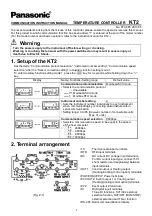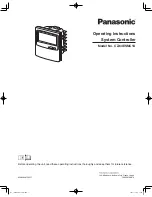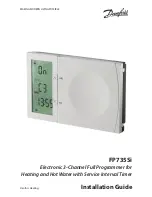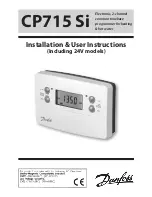
TABLE 2
1) Only with OAU=2CU; 2) Only with IISM different from NON; 3) Only with DS=YES.
*CAUTION: upon changing the display scale SCL, it is ESSENTIAL to reconfigure the parameters related to the absolute (SPL, SPH, SP,
etc.) and differential (HYS, ATL, ATH, etc.) temperatures.
4. THERMOSTAT CONTROL
4.1
Thermostat control is based on comparing the temperature T1, the set point
*SP
and the hysteresis
*HYS
.
Example: SP= 2.0; HYS= 1.5, compressor Off with T1= +2.0° and On with T1= +3.5° (2+1.5).
The compressor only switches On again if the Off time period determined by
CRT
since the previous switchover has elapsed. Whenever
a very small hysteresis HYS must be maintained, it is advised that a suitable value for CRT is selected in order to reduce the number of
starts per hour.
4.2
If sensor T1 fails, the compressor is controlled on a fixed time, through the parameters
CT1
and
CT2
: CT1 determines the run time
and CT2 the rest time.
Example: with CT1=03 and CT2=06 the compressor will cycle 3 minutes On and 6 minutes Off.
Setting CT1=0 causes the compressor to be OFF all the time and, viceversa, with CT1 different from 0, and CT2=0 the compressor will
always be ON.
4.3
If door switch input control has been enabled (DS=YES), parameter
CSD
determines the delay between when the door is opened
and the compressor stopping.
* Actual setpoint and hysteresis depend on the selection
I/II
: in mode
I
, the reference parameters are
SP
and
HYS
while in mode
II
,
IISP
and
IIHY
.
5. DEFROSTING
5.1
Defrosting starts automatically when necessary time has elapsed to obtain the defrosting frequency set with
*DFR
. For example,
with DFR=4 there will be 4 defrostings per 24 hours, so defrosting occurs once every 6 hours. With DFR=0 the timed defrosting function
is removed.
The internal timer is set to zero when power is applied to the controller and at each subsequent defrost start. When the controller is put
on a standby, the accumulated time count is “frozen” (is not incremented).
Defrosting may also be induced manually by pressing the button
for 2 seconds or, with
DI2
=RDS, through the activation of an external
contact (remote defrost start).
During a High Pressure alarm (see par. 7.3 e 7.4) defrost is suspended.
5.2
Once defrost has started, the outputs are controlled according to parameter
DTY
as per the following table:
Table 3
5.3
The actual defrost duration and output activation is determined by a series of parameters.
5.3a. Time termination: T2=NO and T4 different from 2EU. In this case the evaporator temperature is not monitored and defrost
will always last as long as time
DTO
.
5.3b. Temperature monitoring of one evaporator: T2=YES and T4 different from 2EU. In this case, if the sensor T2 measures the
temperature
DLI
before the time DTO elapses, defrost will be terminated in advance.
5.3c. Temperature monitoring of two evaporators: T2=YES, T4=2EU, OAU=2EU. This function is for the control of two independent
evaporators and it switches off the individual heating of the evaporator which gets to temperature DLI first, waiting for the second
evaporator to get to that temperature before the time DTO elapses.
5.4
After defrost, if parameter
DRN
is greater than 0, before cooling starts all outputs will remain off for the time assigned to DRN.
INSTRUCTIONS FOR INSTALLATION AND USE.
DTY
D
EFROST
C
OMPRESSOR
OFF
Off
Off
ELE
On
Off
GAS
On
On
Par.
Adjustment
Function
Sect
FT2
0.. 30 [min]
Timed fan stop
6.1
FT3
0.. 30 [min]
Timed fan run
6.1
ATL
-12.. 0 [°]
Low alarm differential
7.1
ATH
0.. +12 [°]
High alarm differential
7.1
ATD
0.. 120 [min]
Alam temperature delay
7.1
AHT
0.. 75 [°]
Condenser alarm temperature
7.3
AHM
NON/ALR/STP
Condenser high temperature alarm operation 7.3
Par. Adjustment
Function
Sect
OS3
-12.. +12 [°]
Probe T3 offset
2.2
T4
NON/2CU/2EU
Function auxiliary probe T4
1.4
OS4
-12.. +12 [°]
Probe T4 offset
2.2
TLD
1.. 30 [min]
Delay for min./max. temperature storage
8
SIM
0.. 100
Display slowdown
2.2
ADR
1.. 255
Peripheral address
9.6

























